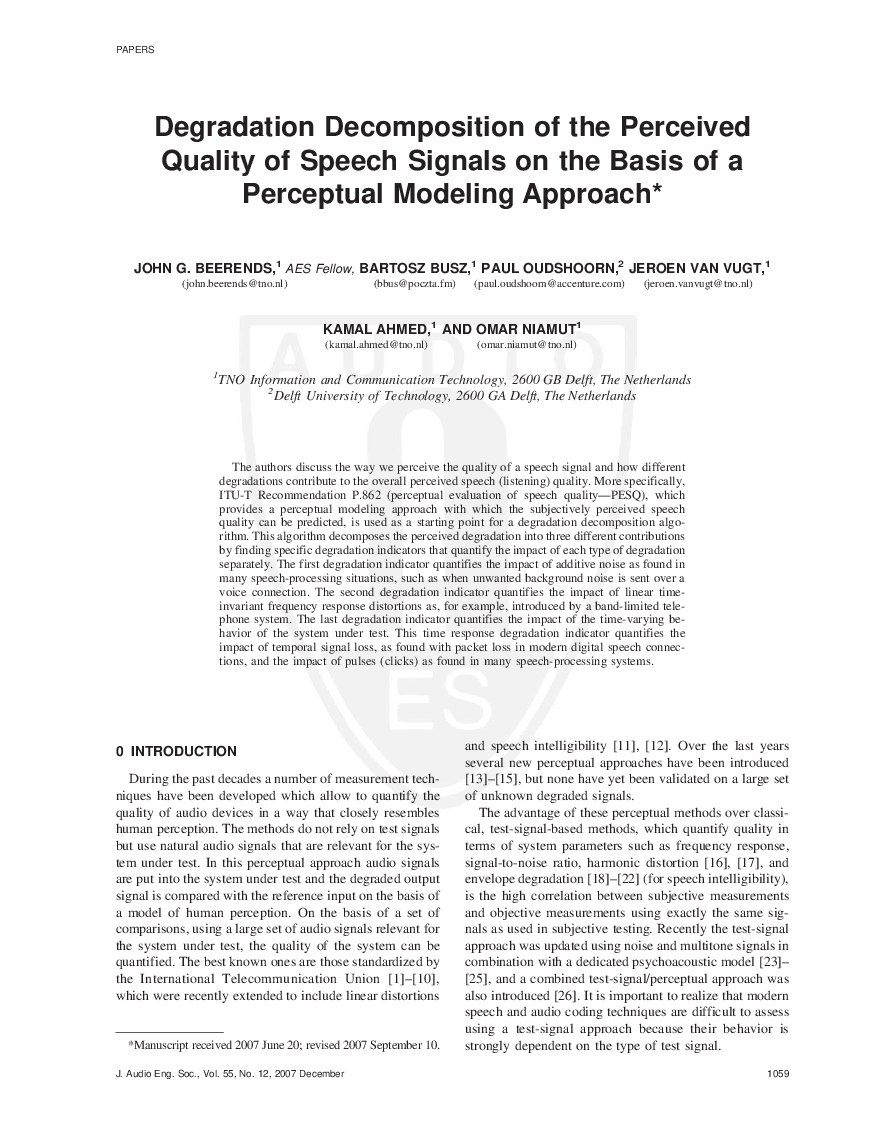Home / Publications / E-library page
You are currently logged in as an
Institutional Subscriber.
If you would like to logout,
please click on the button below.
Home / Publications / E-library page
Only AES members and Institutional Journal Subscribers can download
The authors discuss the way we perceive the quality of a speech signal and how different degradations contribute to the overall perceived speech (listening) quality. More specifically, ITU-T Recommendation P.862 (perceptual evaluation of speech quality—PESQ), which provides a perceptual modeling approach with which the subjectively perceived speech quality can be predicted, is used as a starting point for a degradation decomposition algorithm. This algorithm decomposes the perceived degradation into three different contributions by finding specific degradation indicators that quantify the impact of each type of degradation separately. The first degradation indicator quantifies the impact of additive noise as found in many speech-processing situations, such as when unwanted background noise is sent over a voice connection. The second degradation indicator quantifies the impact of linear timeinvariant frequency response distortions as, for example, introduced by a band-limited telephone system. The last degradation indicator quantifies the impact of the time-varying behavior of the system under test. This time response degradation indicator quantifies the impact of temporal signal loss, as found with packet loss in modern digital speech connections, and the impact of pulses (clicks) as found in many speech-processing systems.
Author (s): Beerends, John G.; Busz, Bartosz; Oudshoorn, Paul; Van Vugt, Jeroen; Ahmed, Kamal; Niamut, Omar
Affiliation:
TNO Information and Communication Technology, Delft, The Netherlands ; Delft University of Technology, Delft, The Netherlands
(See document for exact affiliation information.)
Publication Date:
2007-12-06
Import into BibTeX
Permalink: https://aes2.org/publications/elibrary-page/?id=14182
(1185KB)
Click to purchase paper as a non-member or login as an AES member. If your company or school subscribes to the E-Library then switch to the institutional version. If you are not an AES member Join the AES. If you need to check your member status, login to the Member Portal.

Beerends, John G.; Busz, Bartosz; Oudshoorn, Paul; Van Vugt, Jeroen; Ahmed, Kamal; Niamut, Omar; 2007; Degradation Decomposition of the Perceived Quality of Speech Signals on the Basis of a Perceptual Modeling Approach [PDF]; TNO Information and Communication Technology, Delft, The Netherlands ; Delft University of Technology, Delft, The Netherlands; Paper ; Available from: https://aes2.org/publications/elibrary-page/?id=14182
Beerends, John G.; Busz, Bartosz; Oudshoorn, Paul; Van Vugt, Jeroen; Ahmed, Kamal; Niamut, Omar; Degradation Decomposition of the Perceived Quality of Speech Signals on the Basis of a Perceptual Modeling Approach [PDF]; TNO Information and Communication Technology, Delft, The Netherlands ; Delft University of Technology, Delft, The Netherlands; Paper ; 2007 Available: https://aes2.org/publications/elibrary-page/?id=14182
@article{beerends2007degradation,
author={beerends john g. and busz bartosz and oudshoorn paul and van vugt jeroen and ahmed kamal and niamut omar},
journal={journal of the audio engineering society},
title={degradation decomposition of the perceived quality of speech signals on the basis of a perceptual modeling approach},
year={2007},
volume={55},
issue={12},
pages={1059-1076},
month={december},}
TY – paper
TI – Degradation Decomposition of the Perceived Quality of Speech Signals on the Basis of a Perceptual Modeling Approach
SP – 1059 EP – 1076
AU – Beerends, John G.
AU – Busz, Bartosz
AU – Oudshoorn, Paul
AU – Van Vugt, Jeroen
AU – Ahmed, Kamal
AU – Niamut, Omar
PY – 2007
JO – Journal of the Audio Engineering Society
VO – 55
IS – 12
Y1 – December 2007